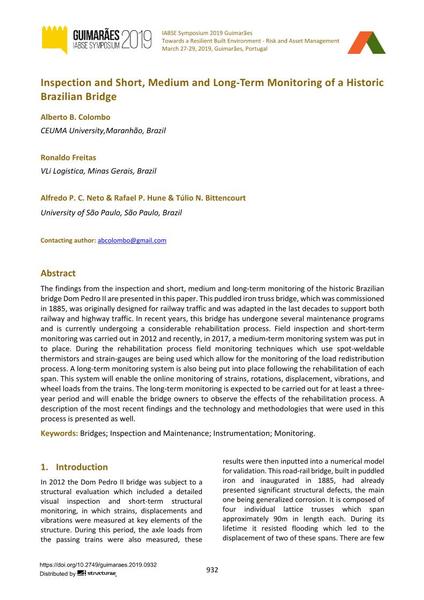Inspection and Short, Medium and Long-Term Monitoring of a Historic Brazilian Bridge

|
|
|||||||||||
Bibliographic Details
| Author(s): |
Alberto B. Colombo
(CEUMA University,Maranhão, Brazil)
Ronaldo Freitas (VLi Logistica, Minas Gerais, Brazil) Alfredo P. C. Neto (University of São Paulo, São Paulo, Brazil) Rafael P. Hune (University of São Paulo, São Paulo, Brazil) Túlio N. Bittencourt (University of São Paulo, São Paulo, Brazil) |
||||
|---|---|---|---|---|---|
| Medium: | conference paper | ||||
| Language(s): | English | ||||
| Conference: | IABSE Symposium: Towards a Resilient Built Environment Risk and Asset Management, Guimarães, Portugal, 27-29 March 2019 | ||||
| Published in: | IABSE Symposium Guimarães 2019 | ||||
|
|||||
| Page(s): | 932-939 | ||||
| Total no. of pages: | 8 | ||||
| DOI: | 10.2749/guimaraes.2019.0932 | ||||
| Abstract: |
The findings from the inspection and short, medium and long-term monitoring of the historic Brazilian bridge Dom Pedro II are presented in this paper. This puddled iron truss bridge, which was commissioned in 1885, was originally designed for railway traffic and was adapted in the last decades to support both railway and highway traffic. In recent years, this bridge has undergone several maintenance programs and is currently undergoing a considerable rehabilitation process. Field inspection and short-term monitoring was carried out in 2012 and recently, in 2017, a medium-term monitoring system was put in to place. During the rehabilitation process field monitoring techniques which use spot-weldable thermistors and strain-gauges are being used which allow for the monitoring of the load redistribution process. A long-term monitoring system is also being put into place following the rehabilitation of each span. This system will enable the online monitoring of strains, rotations, displacement, vibrations, and wheel loads from the trains. The long-term monitoring is expected to be carried out for at least a three- year period and will enable the bridge owners to observe the effects of the rehabilitation process. A description of the most recent findings and the technology and methodologies that were used in this process is presented as well. |
||||
| Keywords: |
bridges Instrumentation monitoring inspection and maintenance
|
||||
